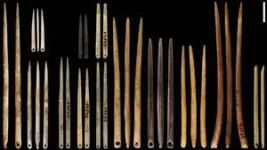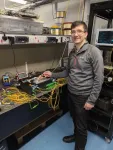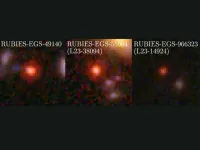(Press-News.org) EMBARGO: 4:00 Sydney AEST June 29 | 14:00 US ET June 28 2024
The beginnings of fashion
Paleolithic eyed needles and the evolution of dress
A team of researchers led by an archaeologist at the University of Sydney are the first to suggest that eyed needles were a new technological innovation used to adorn clothing for social and cultural purposes, marking the major shift from clothes as protection to clothes as an expression of identity.
“Eyed needle tools are an important development in prehistory because they document a transition in the function of clothing from utilitarian to social purposes,” says Dr Ian Gilligan, Honorary Associate in the discipline of Archaeology at the University of Sydney.
From stone tools that prepared animal skins for humans to use as thermal insulation, to the advent of bone awls and eyed needles to create fitted and adorned garments, why did we start to dress to express ourselves and to impress others?
Dr Gilligan and his co-authors reinterpret the evidence of recent discoveries in the development of clothing in their new paper, Paleolithic eyed needles and the evolution of dress.
“Why do we wear clothes? We assume that it’s part of being human, but once you look at different cultures, you realise that people existed and functioned perfectly adequately in society without clothes,” Dr Gilligan says. “What intrigues me is the transition of clothing from being a physical necessity in certain environments, to a social necessity in all environments.
The earliest known eyed needles appeared approximately 40,000 years ago in Siberia. One of the most iconic of Palaeolithic artefacts from the Stone Age, eyed needles are more difficult to make when compared to bone awls, which sufficed for creating fitted clothing. Bone awls are tools made of animal bones that are sharpened to a point. Eyed needles are modified bone awls, with a perforated hole (eye) to facilitate the sewing of sinew or thread.
As evidence suggests bone awls were already being used to create tailored clothes, the innovation of eyed needles may reflect the production of more complex, layered clothing, as well as the adornment of clothes by attaching beads and other small decorative items onto garments.
“We know that clothing up until the last glacial cycle was only used on an ad hoc basis. The classic tools that we associate with that are hide scrapers or stone scrapers, and we find them appearing and going away during the different phases of the last ice ages,” Dr Gilligan explains.
Dr Gilligan and his co-authors argue that clothing became an item of decoration because traditional body decoration methods, like body painting with ochre or deliberate scarification, weren’t possible during the latter part of the last ice age in colder parts of Eurasia, as people were needing to wear clothes all the time to survive.
“That’s why the appearance of eyed needles is particularly important because it signals the use of clothing as decoration,” Dr Gilligan says. “Eyed needles would have been especially useful for the very fine sewing that was required to decorate clothing.”
Clothing therefore evolved to serve not only a practical necessity for protection and comfort against external elements, but also a social, aesthetic function for individual and cultural identity.
The regular wearing of clothing allowed larger and more complex societies to form, as people could relocate to colder climates while also cooperating with their tribe or community based on shared clothing styles and symbols. The skills associated with the production of clothing contributed to a more sustainable lifestyle and enhanced the long-term survival and prosperity of human communities.
Covering the human body regardless of climate is a social practice that has endured. Dr Gilligan’s future work moves beyond the advent of clothing as dress and looks at the psychological functions and effects of wearing clothes.
“We take it for granted we feel comfortable wearing clothes and uncomfortable if we’re not wearing clothes in public. But how does wearing clothes impact the way we look at ourselves, the way we see ourselves as humans, and perhaps how we look at the environment around us?”
EMBARGO: 4:00 Sydney AEST June 29 | 14:00 US ET June 28 2024
INTERVIEWS
Dr Ian Gilligan | ian.gilligan@sydney.edu.au
MEDIA ENQUIRIES
Liv Clayworth | 0412 480 263, olivia.clayworth@sydney.edu.au
RESEARCH
Gilligan et al. ‘Paleolithic eyed needles and the evolution of dress.’ Science Advances.
Research paper link (live when embargo lifts): https://www.science.org/doi/10.1126/sciadv.adp2887
DOI: 10.1126/sciadv.adp2887 https://doi.org/10.1126/sciadv.adp2887
IMAGES
Download photos of researcher, Dr Ian Gilligan, images of paleolithic tools and stages in the evolution of clothing, and an artist’s depiction here.
VIDEO FOOTAGE
Download interview footage with Dr Ian Gilligan explaining the research here.
DECLARATION
The authors declare no competing interests.
FUNDING
This research was supported by the following agencies: Initiative d’Excellence IdEx, University of Bordeaux, Talent program #191022-001; French government in the framework of the University of Bordeaux’s IdEx “Investments for the Future” program / GPR “Human Past”; Research Council of Norway, Centres of Excellence (SFF), Centre for Early Sapiens Behaviour, SapienCE #262618; European Research Council Synergy Grant for the project Evolution of Cognitive Tools for Quantification (QUANTA) #951388; The National Social Science Foundation of China #20&ZD246, The Taishan Scholars Project Special Funds #003, State Assignment of the Sobolev Institute of Geology and Mineralogy # 122041400252-1, Siberian Branch of the Russian Academy of Sciences.
END
The beginnings of fashion
Paleolithic eyed needles and the evolution of dress
2024-06-28
ELSE PRESS RELEASES FROM THIS DATE:
Why some tumors are resistant to cell therapies
2024-06-28
FRANKFURT. In congratulating the CARISMa scientists, Goethe University President Prof. Enrico Schleiff said: “The new LOEWE network sets up in Hesse an innovative research program that is currently gathering steam all over the world. It also expands Goethe University’s existing research profile and broadens our network of cooperation partners in the field of CAR cell therapy [editor’s note: CAR is the abbreviation for chimeric antigen receptor]. The network deliberately builds on our university’s ...
Can A.I. tell you if you have osteoporosis? Newly developed deep learning model shows promise
2024-06-28
Osteoporosis is so difficult to detect in early stage it’s called the “silent disease.” What if artificial intelligence could help predict a patient’s chances of having the bone-loss disease before ever stepping into a doctor’s office?
Tulane University researchers made progress toward that vision by developing a new deep learning algorithm that outperformed existing computer-based osteoporosis risk prediction methods, potentially leading to earlier diagnoses and better outcomes for patients with osteoporosis risk.
Their results were recently published in ...
Work-related nerve injuries are common with repetitive motions
2024-06-28
Although you may not always realize it, many of the jobs you do can put strain on, and even cause damage to, your nerves.
Sandra Hearn, M.D., the associate chair of Education and Professional Development in the Department of Physical Medicine and Rehabilitation, and a team of collaborators, set out to better understand the causes of occupational nerve injuries.
What is an occupational nerve injury?
An occupational nerve injury refers to a problem with your peripheral nerves that's caused by a work-related activity. It's often seen ...
Mount Sinai study reveals significant differences in RNA editing between postmortem and living human brain
2024-06-28
Researchers from the Icahn School of Medicine at Mount Sinai have shed valuable light on the nuanced functions and intricate regulatory methods of RNA editing, a critical mechanism underlying brain development and disease.
In a study published June 26 in Nature Communications, the team reported finding major differences between postmortem and living prefrontal cortex brain tissues as they relate to one of the most abundant RNA modifications in the brain, known as adenosine-to-inosine (A-to-I) editing. This discovery will play a significant role ...
Penn researchers will investigate link between TBI and dementia with $10M NIH grant
2024-06-28
PHILADELPHIA— A team of researchers led by Penn Medicine will investigate the link between traumatic brain injuries (TBI) and Alzheimer’s disease and related dementias (ADRD) over the next five years with a $10 million grant from the National Institute of Neurological Disorders and Stroke (NINDS). Using an extensive tissue bank including over 1,000 samples, the researchers aim to uncover the underlying biological mechanisms of TBI-related neurodegeneration (TReND) from a variety of brain injury types. ...
Aston University researchers break ‘world record’ again for data transmission speed
2024-06-28
Aston Institute of Photonic Research academics are part of a team that sent data at a rate of 402 terabits per second
This beats their previous record of 301 terabits per second
They constructed the first optical transmission system covering six wavelength bands.
Aston University researchers are part of a team that has sent data at a record rate of 402 terabits per second using commercially available optical fibre.
This beats their previous record, announced in March 2024, of 301 terabits or 301,000,000 megabits per second using a single, standard optical fibre.
"If compared to the internet connection speed recommendations of Netflix, of 3 Mbit/s ...
A few surgical procedures account for high number of opioid prescriptions
2024-06-28
A handful of common surgical procedures account for large shares of all opioids dispensed after surgery in children and adults, according to two studies recently published by researchers at the University of Michigan.
The studies, published this week in Pediatrics and JAMA Network Open, report that the top three procedures for children ages 0-11 account for 59% of opioids dispensed after surgery (tonsillectomies and adenoidectomies 50%, upper extremity fractures 5% and removal of deep implants 4%). Among those ages 12-21, the top three procedures account for ...
Clemson University bioengineer receives $2.1 million SBIR grant to develop long-lasting natural disinfectants superior to currently available disinfectants
2024-06-28
Alexey Vertegel, Ph.D., Associate Professor in the Department of Bioengineering, Clemson University, has been awarded a $2.1M Small Business Innovation Research (SBIR) Phase II grant from the National Institute of Allergy and Infectious Diseases (NIAID) to develop long-lasting natural disinfectants. Currently used surface disinfectants provide high-level activity over a relatively short period of time, typically less than 4 hours. During the Phase I study, his team developed a novel film-forming disinfectant based on chitosan, alcohol, and a natural antimicrobial, which is slowly released from the ...
Elke Arenholz named director of the National Synchrotron Light Source II at Brookhaven Lab
2024-06-28
UPTON, N.Y. — Elke Arenholz, a renowned scientist known for her expertise in magnetic materials and X-ray spectroscopy, scattering, imaging, and instrument development, has been named director of the National Synchrotron Light Source II (NSLS-II), a U.S. Department of Energy (DOE) Office of Science user facility at DOE’s Brookhaven National Laboratory, effective August 2024.
Arenholz’s appointment comes following a search that began in summer 2023 after John Hill, the previous director of NSLS-II, ...
Tiny bright objects discovered at dawn of universe baffle scientists
2024-06-28
UNIVERSITY PARK, Pa. — A recent discovery by NASA’s James Webb Space Telescope (JWST) confirmed that luminous, very red objects previously detected in the early universe upend conventional thinking about the origins and evolution of galaxies and their supermassive black holes.
An international team, led by Penn State researchers, using the NIRSpec instrument aboard JWST as part of the RUBIES survey identified three mysterious objects in the early universe, about 600-800 million years after the Big Bang, ...
LAST 30 PRESS RELEASES:
Singapore scientists discover lung cancer's "bodyguard system" - and how to disarm it
Bacteria use wrapping flagella to tunnel through microscopic passages
New critique prompts correction of high-profile Yellowstone aspen study, highlighting challenges in measuring ecosystem response to wolf reintroduction
Stroke survivors miss critical treatment, face greater disability due to systemic transfer delays
Delayed stroke care linked to increased disability risk
Long term use of anti-acid drugs may not increase stomach cancer risk
Non-monetary 'honor-based' incentives linked to increased blood donations
Natural ovulation as effective as hormones before IVF embryo transfer
Major clinical trial provides definitive evidence of impacts of steroid treatment on severe brain infection
Low vitamin D levels shown to raise risk of hospitalization with potentially fatal respiratory tract infections by 33%
Diagnoses of major conditions failing to recover since the pandemic
Scientists solve 66 million-year-old mystery of how Earth’s greenhouse age ended
Red light therapy shows promise for protecting football players’ brains
Trees — not grass and other greenery — associated with lower heart disease risk in cities
Chemical Insights scientist receives Achievement Award from the Society of Toxicology
Breakthrough organic crystalline material repairs itself in extreme cold temperatures, unlocking new possibilities for space and deep-sea technologies
Scientists discover novel immune ‘traffic controller’ hijacked by virus
When tropical oceans were oxygen oases
Positive interactions dominate among marine microbes, six-year study reveals
Safeguarding the Winter Olympics-Paralympics against climate change
Most would recommend RSV immunizations for older and pregnant people
Donated blood has a shelf life. A new test tracks how it's aging
Stroke during pregnancy, postpartum associated with more illness, job status later
American Meteorological Society announces new executive director
People with “binge-watching addiction” are more likely to be lonely
Wild potato follows a path to domestication in the American Southwest
General climate advocacy ad campaign received more public engagement compared to more-tailored ad campaign promoting sustainable fashion
Medical LLMs may show real-world potential in identifying individuals with major depressive disorder using WhatsApp voice note recordings
Early translational study supports the role of high-dose inhaled nitric oxide as a potential antimicrobial therapy
AI can predict preemies’ path, Stanford Medicine-led study shows
[Press-News.org] The beginnings of fashionPaleolithic eyed needles and the evolution of dress






